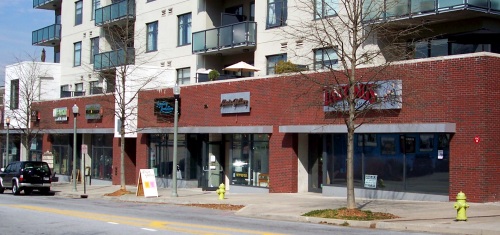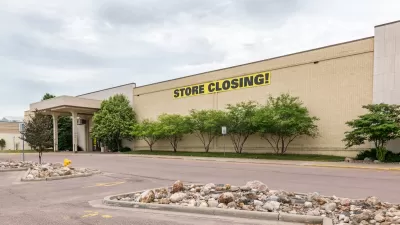Why do Main St. redevelopments get it wrong so much of the time? Scott Doyon of Placemakers says there is a ton of environmental behavior research that is going unheeded, and developers need to stop trying so hard and let individual expression flourish.
 In taking on the foibles of our built environment, author James Howard Kunstlermakes a point of noting that he's neither an architect nor planner. Instead, he's the everyman, and his profession is dutifully pointing out that the emperor has no clothes.
In taking on the foibles of our built environment, author James Howard Kunstlermakes a point of noting that he's neither an architect nor planner. Instead, he's the everyman, and his profession is dutifully pointing out that the emperor has no clothes.
I'm in a similar position. I'm not an architect or planner either (or a retail consultant, for that matter). I'm an interpreter of such folks, taking the wonky banter that characterizes their various disciplines and making it accessible to the concerns and interests of regular, everyday people.
My perspective comes from common sense osmosis, not formal instruction. Granted, I may still wear disciplinary blinders to some degree, but I propose they're less a bulky optical barrier to greater context and more like something Lou Reed would have worn in 1968.
Today, I set my gaze on Main Street retail. Probably to the chagrin of my far more educated colleagues.
All across the country, Main Street retail is hurting. In some cases, this is a reflection of far more complex, and often regional, economic factors. But in others, it's in places that have made great strides towards creating (or recreating) thriving downtowns.
That's the kind of place I'm talking about. As our urban renaissance gathers greater momentum, we need to look at ways that common practices can either help or hinder municipal efforts to encourage a more viable economic environment.
Retail consultant Bob Gibbs often stresses that, for Main Street to be successful, it needs to heed the lessons of the mall. Reduced to a sound bite, this is often cynically dismissed as a suggestion to "mall-ify downtown," but Bob's suggestion actually reflects a much more nuanced reality: For decades, the business of malls has driven meticulous study of consumer behaviors. Literally reams and reams of data exist, telling savvy retailers everything from how to keep shoppers shopping to why they walk into one store and not another to which way they'll turn once they get in the door.
Good, old-fashioned human behavior stuff. Universal and predictable. Which is why it's just as important to the many hands of Main Street as it is to the top-down tyranny of the mall. Understanding what attracts people, and what repels them, is a constant. And what you'll find is that certain details have surprising impact. None are killers or saviors in their own right, just potential barriers or assets towards larger goals.
So what happens when a city does its job–engineering walkable streets, making urban-friendly revisions to its zoning ordinance, recruiting business and development–and it’s time for the private sector to take over? To my eye, a lot of good but also a looming potential for missed opportunities.
Below are a variety of examples of what can happen, taken from my own town of Decatur, Georgia, five miles east of downtown Atlanta, site of the upcoming CNU 18:

This is a classic instance of an architect committing the sin of forced variety, which reflects both a cursory understanding that diversity provides interest and a developer’s fear that unrestrained expression by individual tenants will impact the marketable value of the units above. Thus the crudely differentiated facades at street level, which attempt to provide said diversity but in a controlled and sanitized way, coupled with signage and awnings that are meticulously coordinated.
Ironically, the resulting mish mash lacks both the allure of authentic, organic diversity and the modernist appeal of artistically-minded aesthetic consistency.
Other projects avoid such temptations for forced differentiation, sticking instead with safe consistency:

The problem, as my colleague Nathan Norris points out often, is that, by playing it safe aesthetically in the form of consistent signage and awnings, it’s “boring the humans.” That is, in trying to remove any element of unpredictability, it takes on a level of banality completely devoid of the very elements of unexpected visual interest and delight that draw people.
Such attempts at safe consistency aren't limited to traditional projects. Here, a postmodern project attempts something similar. The difference, to its credit, is that its approach to signage allows retailers more freedom in their brand expression and that can be an interesting thing. However, it occurs in a way that's far more oriented towards passing traffic than towards pedestrians on the sidewalk. For them, it's still an overly-sterilized environment:

Similar results occur when comparable tactics are applied to older properties. Below, in an effort to improve the presentation of an historic commercial strip, oversized coordinated awnings were added which, in addition to hampering individual retailers’ ability to differentiate themselves through unique branding, also limit visibility of individual enterprises:

So what does work? First and foremost, avoiding the conventional wisdom of the last fifty years. As we've increasingly separated our retail from our office from our residential, it's become incumbent on each individual project to be the whole. Create a total environment or folks might drive somewhere else. But Main Street is counterintuitive to such thinking. Each individual project is not the whole but, rather, is plugging into and contributing to something larger.
Simplicity trumps over-thinking. Diversity beats consistency. Many hands outperform controlled authority.
Consider this example of getting things right. From a developer or landlord's perspective, it requires the least effort. It's essentially one building, with no great investment in reinvention architecture, broken up into a series of shopfronts. Each is given a blank, easily modified canvas and afforded the freedom to be who they are. In response, the whole becomes infinitely more compelling, not just to shoppers but to anyone, than any of the examples already provided:

What emerges? Different colors. Different approaches to awnings. Different types of lighting and signage. In short, a more intriguing and inviting environment and a greater contribution to the whole. Even from the perspective of marketing upstairs residential units, which often drives the skittish, overly programmed approach (common with new downtown projects), it's far easier to sell life on a happening block than on a block gap-toothed with empty storefronts where no one willfully chooses to shop.
Not surprisingly, all of this is just the tip of the iceberg when it comes to making Main Street work. But it’s a good place to start, as cities and city boosters increasingly come to understand that getting buildings to meet the sidewalk is just the start of getting them right.
As for right now, I wouldn’t say the emperor has no clothes. I’d just suggest he rethink the outfit.
Scott Doyon is a principal and director of client marketing services at Placemakers. He makes sense of place, translating the technical issues of traditional urbanism into plain English, then employing the necessary messaging strategies and graphic executions to maximize public engagement and buy-in. A communications and marketing veteran, schooled from 11 years with global branding powerhouse J Walter Thompson, he excels at illuminating the benefits of well-crafted urbanism, and applies those skills to both public process and brand marketing initiatives for urban development projects. He lives in Decatur, Georgia.
This article originally appeared in the Placemakers blog.

Planetizen Federal Action Tracker
A weekly monitor of how Trump’s orders and actions are impacting planners and planning in America.

Maui's Vacation Rental Debate Turns Ugly
Verbal attacks, misinformation campaigns and fistfights plague a high-stakes debate to convert thousands of vacation rentals into long-term housing.

Restaurant Patios Were a Pandemic Win — Why Were They so Hard to Keep?
Social distancing requirements and changes in travel patterns prompted cities to pilot new uses for street and sidewalk space. Then it got complicated.

In California Battle of Housing vs. Environment, Housing Just Won
A new state law significantly limits the power of CEQA, an environmental review law that served as a powerful tool for blocking new development.

Boulder Eliminates Parking Minimums Citywide
Officials estimate the cost of building a single underground parking space at up to $100,000.

Orange County, Florida Adopts Largest US “Sprawl Repair” Code
The ‘Orange Code’ seeks to rectify decades of sprawl-inducing, car-oriented development.
Urban Design for Planners 1: Software Tools
This six-course series explores essential urban design concepts using open source software and equips planners with the tools they need to participate fully in the urban design process.
Planning for Universal Design
Learn the tools for implementing Universal Design in planning regulations.
Heyer Gruel & Associates PA
JM Goldson LLC
Custer County Colorado
City of Camden Redevelopment Agency
City of Astoria
Transportation Research & Education Center (TREC) at Portland State University
Jefferson Parish Government
Camden Redevelopment Agency
City of Claremont





























